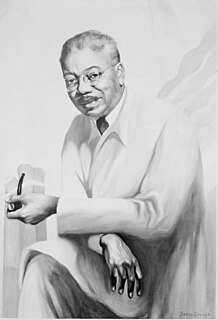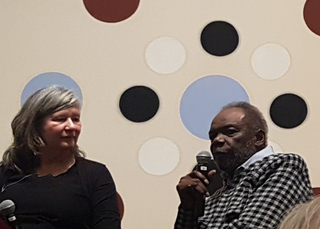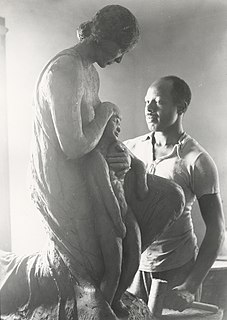Related Research Articles

The Anacostia Community Museum is a community museum in the Anacostia neighborhood of Washington, D.C., in the United States. It is one of twenty museums under the umbrella of the Smithsonian Institution and was the first federally funded community museum in the United States. The museum, founded in 1967, was created with the intention to bring aspects of the Smithsonian museums, located on the National Mall, to the Anacostia neighborhood, with the hope that community members from the neighborhood would visit the main Smithsonian museums. It became federally funded in 1970 and focuses on the community in and around Anacostia in its exhibitions. This museum also houses a library.

Aaron Douglas was an American painter, illustrator and visual arts educator. He was a major figure in the Harlem Renaissance. He developed his art career painting murals and creating illustrations that addressed social issues around race and segregation in the United States by utilizing African-centric imagery. Douglas set the stage for young, African-American artists to enter public arts realm through his involvement with the Harlem Artists Guild. In 1944, he concluded his art career by founding the Art Department at Fisk University in Nashville, Tennessee. He taught visual art classes at Fisk until his retirement in 1966. Douglas is known as a prominent leader in modern African-American art whose work influenced artists for years to come.
Sue Coe is an English artist and illustrator working primarily in drawing, printmaking, and in the form of illustrated books and comics. Her work is in the tradition of social protest art and is highly political. Coe's work often includes animal rights commentary, though she also creates work that centralizes the rights of marginalized peoples and criticizes capitalism. Her commentary on political events and social injustice are published in newspapers, magazines and books. Her work has been shown internationally in both solo and group exhibitions and has been collected by various international museums. She lives in Upstate New York.

Sam Gilliam is an African-American color field painter and lyrical abstractionist artist. Gilliam is associated with the Washington Color School, a group of Washington, D.C. area artists that developed a form of abstract art from color field painting in the 1950s and 1960s. His works have also been described as belonging to abstract expressionism and lyrical abstraction. He works on stretched, draped and wrapped canvas, and adds sculptural 3D elements. He is recognized as the first artist to introduce the idea of a draped, painted canvas hanging without stretcher bars around 1965. This was a major contribution to the Color Field School.

Thelma Beatrice Johnson Streat was an African-American artist, dancer, and educator. She gained prominence in the 1940s for her art, performance and work to foster intercultural understanding and appreciation.
Thomas Sills was a painter and collagist and a participant in the New York Abstract Expressionist movement. At the peak of his career in the 1960s and 1970s, his work was widely shown in museums. His work was regularly featured in art journals and is in museum collections.

Grafton Tyler Brown was an American painter, lithographer and cartographer. Brown was the first African-American artist to create works depicting the Pacific Northwest and California.
Arturo Lindsay is a Panamanian born artist and Professor of Art and Art History at Spelman College. His scholarship specializes in ethnographic research on African spiritual and aesthetic retentions in contemporary American cultures. His Panamanian/American identity is reflected in his art, which focuses on African culture in America.
The Barnett-Aden Gallery was a nonprofit art gallery in Washington D.C. founded by James V. Herring and Alonzo J. Aden, who were associated with Howard University's art department and gallery. The gallery, which opened on October 16, 1943 and operated until 1969, was the first successful Black-owned private art gallery in the United States; showcased numerous important artists; and became an important, racially integrated part of the artistic and social worlds of 1940s and 1950s Washington, D.C.
Annette Weintraub is an American new media artist and writer.
Elizabeth Talford Scott was an American folk artist, known for her quilts.

Edith T. Martin is an American artist and museum professional.

Oliver LaGrone was an African-American sculptor, poet, educator, and humanitarian. In 1974 a post-secondary scholarship was created in his name, enlarged and refocused in 1991 for graduates of the public high school of Harrisburg, Pennsylvania.
Muriel Magenta née Zimmerman is an American visual artist working in new media genres of computer art, installation, multimedia performance as well as video and sculpture. Magenta is Professor of Art at Arizona State University.

Naomi Siegler Savage was an American photographer.

The Johnson desk is a mahogany partners desk that was used by U.S. President Lyndon B. Johnson in the Oval Office as his Oval Office desk. One of only six desks used by a president in the Oval Office, it was designed by Thomas D. Wadelton and built in 1909 by S. Karpen and Bros. in Chicago. The desk was built as part of 125 seven-piece office sets for senators' offices in the Russell Senate Office Building, and was used by Johnson during his terms as U.S. Senator, Vice President, and President. It is currently located at Lyndon Baines Johnson Library and Museum as part of a replica Oval Office.
Joseph Holston is an American painter and printmaker known for his portrayals of the African American experience, using vivid colors and expressive lines in a cubist-abstractionist style. His media include painting, etching, silk screen, and collage.
Colette Stuebe Bangert is an American artist and new media artist who has created both computer-generated and traditional artworks. Her computer-generated artworks are the product of a decades-long collaboration with her husband, Charles Jeffries "Jeff" Bangert (1938–2019), a mathematician and computer graphics programmer. Bangert's work in traditional media includes painting, drawing, watercolor and textiles.
Prema Murthy is an American, multi-disciplinary artist based in New York. Employing aesthetics, gesture, geometry and algorithmic processes, Murthy's work explores the boundaries between embodiment and abstraction, while engaging in issues of culture and politics. Her work has been exhibited nationally and internationally at MoMA PS1, the Whitney Museum of American Art, the New Museum of Contemporary Art, the Reina Sofia Museum, the Generali Foundation in Vienna, and the India Habitat Center-New Delhi.
Kō Nakajima is a Tokyo-based Japanese video artist, photographer, and inventor. His photographs of conceptual artist Yutaka Matsuzawa are a key resource for understanding Matsuzawa’s practice. Video Earth, the collective Nakajima founded with his students at Tokyo College of Photography, is one of the earliest video collectives in Japan, roughly contemporaneous with Video Hiroba. Nakajima was also a prolific experimenter and inventor, working with Sony and JVC to create the Animaker and the Aniputer, respectively. Since the late 1960s he has participated in numerous international film and video festivals, and supported the work of younger generations of artists as a mentor.
References
- Meek, Vicki. Beta Projections and Artifacts from Earth, Art Lies: Contemporary Art Quarterly 53 (Spring 2007), p. 122
- Smithsonian Anacostia Museum, New Visions: Emerging Trends in African American Art (catalog), pp. 12–13
- ACM SIGGRAPH 2003, "Electronic Art and Animation" (catalog), p. 105
- Lyndon Baines Johnson Library and Museum, "Our New Day Begun: African American Artists Entering the Millennium" (catalog), pp. 7, 41, 56